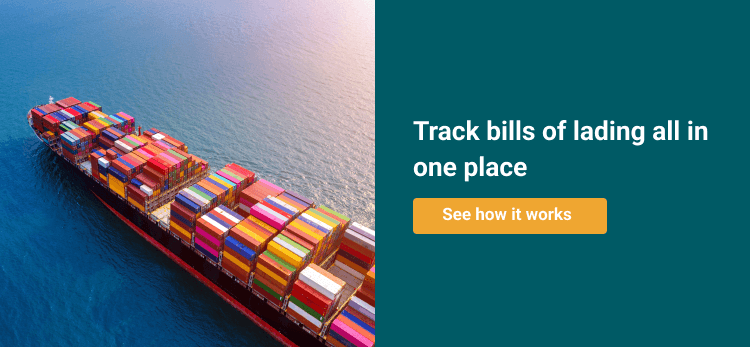To track a bill of lading means hours of manual coordination with various stakeholders, which can soon turn into a frustrating experience. Luckily, with technological advancements, automation of real-time data about your container’s whereabouts is now possible. Find out how Container xChange can help you track your BL in 4 easy ways using digital innovations.
Are you tired of trying to track bill of lading using a tracking service or carrier website? These platforms are often unreliable, inefficient and time-consuming.
Tracking your shipment via the BL goes hand in hand with keeping tabs on your box. After all, container tracking is important for you to know where your containers are, ideally at all times. If there’s a problem or a delay, you need to be able to communicate this to your customers, as quickly as possible.
That’s why on Container xChange, we wanted to make this process as fast and efficient for you with our digitized offerings. Here’s how we can help:
Track bill of lading at your fingertips with Container xChange
At Container xChange, we’ve created a service that allows you to track your shipments automatically, without the constant manual input. All you have to do is monitor your tracking dashboards and keep an eye out for issues. All tracking data is stored in the system, and is easily accessible, anywhere and at any time.
Say goodbye to tedious hours spent inputting bill of lading numbers and manually organizing information. Now you can access the information you need easily with just a few clicks. We let you focus on what’s important; your customers, and we do the rest.
It gets even better!
Container xChange enables you to manage not only your container tracking but your entire container logistics workflow, all in one place.
We’re a neutral platform connecting container owners and users. With over 50,000 containers available to lease or buy, in over 2,500 locations worldwide. We offer the best prices for both buying and leasing containers. All of our members are vetted and come with our stamp of approval, so you don’t have to worry about scams or fraud.
Once you become a member, you’ll have access to our leasing and buying platforms, tracking services, and so much more.
We’re here to help you track boxes easily. Start your journey today, by scheduling a free demo of our platform.
Track bill of lading with these companies
Digitizing your workflow process is the way of the future. Check out these companies who add to the world of digitalization:
Shipment Link
With Shipment Link, you can choose ‘quick tracking’ or ‘multiple tracking’ (the first option is for quickly checking on a shipment, and the second is for checking on more than one). You can track your containers using the bill of lading number, the booking number, or the container number.
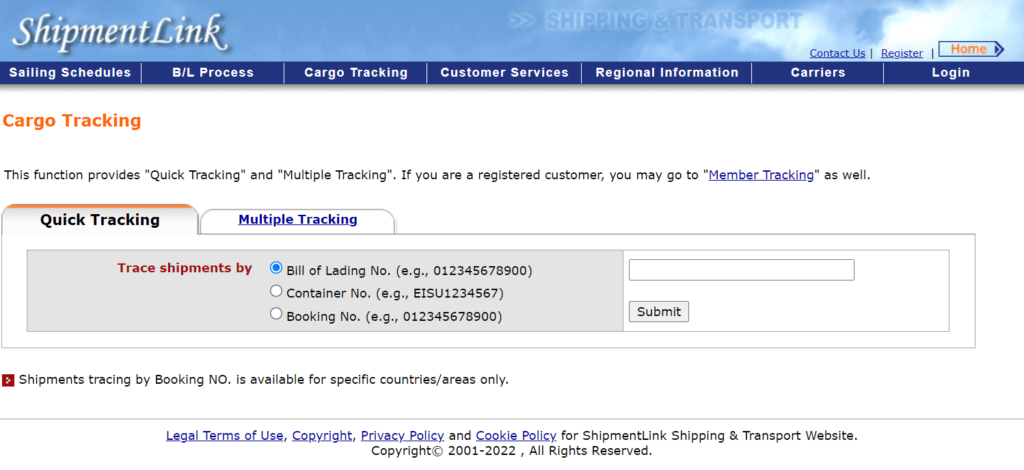
Track Trace
Track Trace uses the bill of lading numbers with the format XXXX123456789.
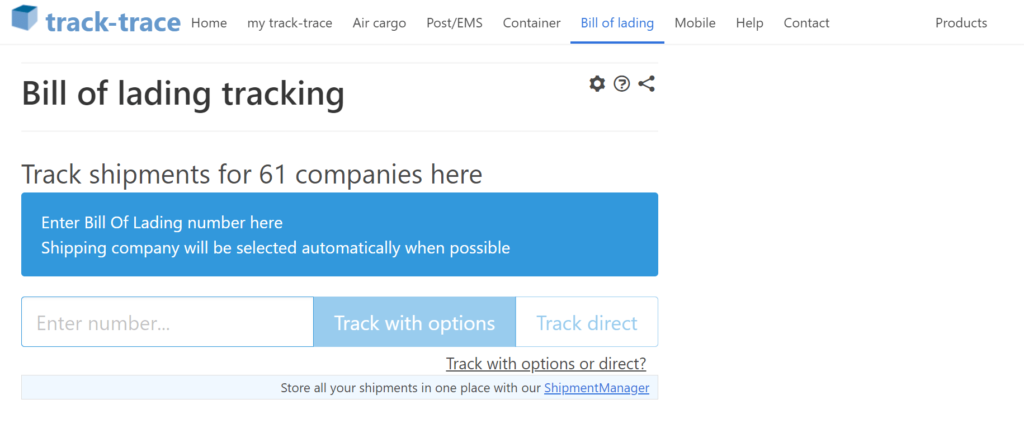
The first 4 letters are used to automatically send a request to the correct company.
If the company isn’t supported, or you want to select a specific company, this can be done manually after tracking.
Shipup
With Shipup, you get one free tracking per week, otherwise, a fee is required to track containers. Again, you can track using the bill of lading number, container number, or booking number.
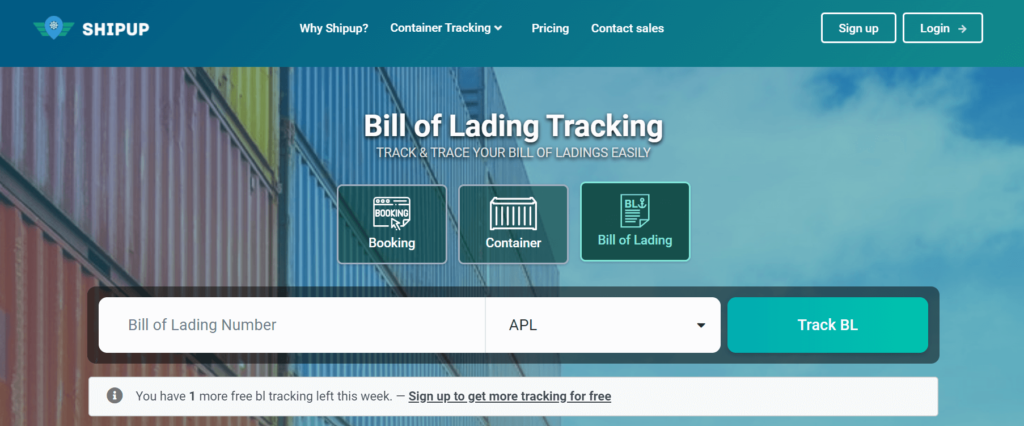
Registration is needed in order to track a shipment more than once a week.
BoL number tracking: Importance of container monitoring in the shipping industry
You know what it’s like. A shipment has run late again. You didn’t get enough warning (or any), and now your customers are unhappy. Maybe they even left a scathing review on your website. This impacts negatively on your sales, and your business as a whole, not to mention your customer relations. No one wants that.
These days, various technologies are used in an attempt to make the shipping and transport process more transparent and traceable. These include big data, live location, and automation. Automated and digitized international container search is now slowly becoming more commonplace, but not nearly fast enough to keep up with the demand.
Container tracking systems help the logistics industry in various ways. This includes obtaining the exact location of cargo at various times, gathering port details, and tracking a container anywhere, anytime, without limitations. All of these are very useful for the container user or owner.
Here are some of the most widely-used tracking systems available at present:
![]()
How to track bill of lading in shipping
Unfortunately, the shipping industry is massive, and with so many moving parts, you’ve always got to factor in uncertainties and potential issues. This may never change. The main thing is that shippers know about these issues so that they can plan accordingly. Knowing where containers are, as well as their current status is infinitely helpful in pre-empting problems, keeping customers happy, and costs down.
As we know, this age-old industry has been snail-like in adopting new methods, leaving many parties frustrated and permanently out of the loop. With so many players involved, it’s no wonder communication is difficult and often gets lost. Things are far from efficient.
Thanks to recent innovations, there are ways to completely change how tracking is managed, with real-time data collection, and automated tracking software.
The good news is, xChange has created such a service.
At xChange, we track containers through several different channels. Information is pulled from carrier websites, depots, carrier reports, terminals, and xChange forecasts. This information is available via user-friendly dashboards.
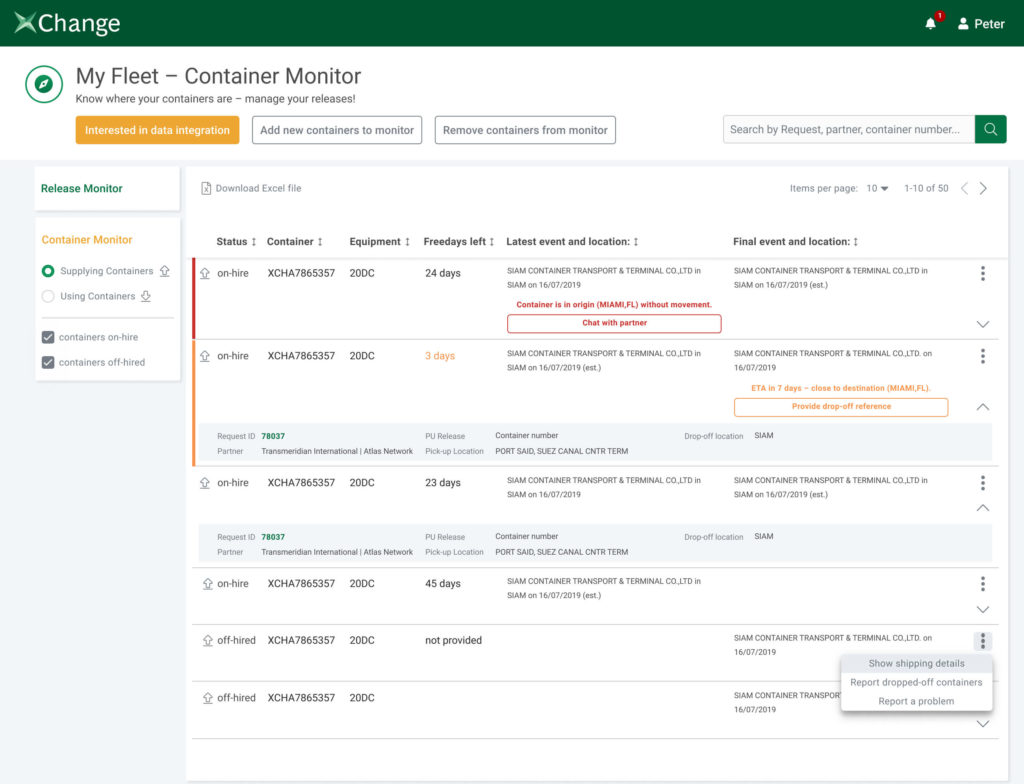
With our platform, it’s also possible to track containers outside of Container xChange. Our API tracking allows users to integrate their equipment management systems with our system, as well as to export data as CSV or excel files. Now you can have all of your data neatly compiled, with just the click of a button!
On the dashboard, you can search for containers using container numbers, find partners, check for releases, and receive alerts.
You can also see as much or as little data as you want, from tracking multiple containers at once to honing in on the details of just one.
If you’re tired of inefficient tracking systems and hours wasted inputting data, it’s time to join Container xChange, and automate your container logistics and tracking processes.
Click below to learn more about tracking your container with us.
What is a bill of lading?
A bill of lading is an important document for tracking the whereabouts of a shipment during its long journey across the ocean. It’s basically a list containing legally binding information. The bill of lading acts as a receipt of freight services. It contains details about the cargo, such as the type, quantity and destination of the items.
The bill of lading ensures that the carrier delivers the shipment in good condition to the consigneeWhat is a consignee? When transporting freight (by ocean, air, or land), there are two parties involved — one who is shipping and the other who is receiving the freight. The recipient of the goods b... More (importer). It’s also particularly important for international trade, acting as proof of ownership over the goods being transported. It would be nearly impossible to transport goods internationally without this crucial piece of paper.
One of the easiest ways to track your shipment is by using the bill of lading number. So if you’re looking at your bill of lading document, you’ll find the BL number at the top right-hand corner of the document, next to the words ‘BOL #’. The number is a combination of 4 letters (the carrier’s code), followed by an 8, 10 or 12-digit code.
An example of a bill of lading number would be MSC17392833. You’re also going to need the shipping line name in order to track a bill of lading successfully.
Bill of lading example
You may be familiar with what a bill of lading document looks like, or you may not be. For those who aren’t, here’s an example:
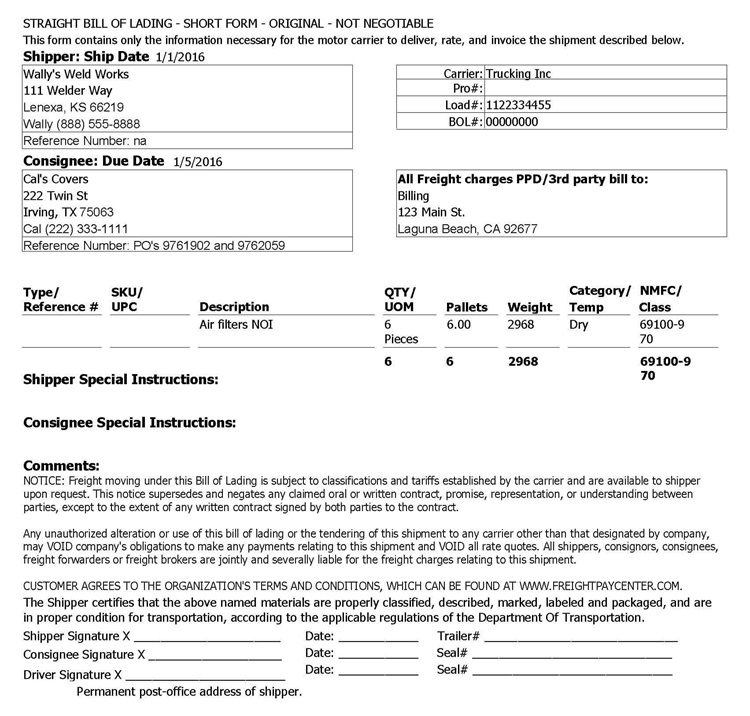
BL tracking: Current challenges
In a bustling industry that transports millions of containers every single year, container search technology is more important than ever before.
As of January 2023, the cargo traffic at some of the main ports in India reached up to 70.12 million tonnes. That’s an increase of 12.2% as compared to the previous year.
The constantly rising demands within the logistics industry make it increasingly difficult for container owners and shippers to keep an eye on their stock, and to track bills of lading easily.
Some of the biggest obstacles currently faced in the industry include:
- Shipping companies not having adequate time and resources for efficient international container search technologies
- Limited end-to-end transparency between parties along the supply chain
- The siloing of information, rather than sharing it between stakeholders
- Lack of standardization of systems, which makes it difficult to share real-time data
- Tracking shipper-owned containers are expensive and labor-intensive, leading to frustration
- Lack of digitization of trade documentation within the industry
The paperless bill of lading or electronic bill of lading (EBOL) was introduced in October of 2022. Which is merely the process of digitizing trade documentation such as the paper bill of lading. Trade paperwork is a time-consuming and resource-intensive procedure. A digital bill of lading might save $6.5 billion in direct costs while facilitating $40 billion in global trade.
The paperless route seems like a much easier alternative than having to scramble to get your documents in order, or worse, losing them. Now, imagine you could have access to all these documents stored safely in one place, online?
Read on to learn more about how Container xChange can make this happen by digitizing your container logistics in a safe and efficient way.
Upgrade to automation to track bill of lading with Container xChange
We know that tracking is a serious pain point for you. That’s why we’ve created xChange Tracking. The smart tracking solution gathers tracking information and displays it conveniently in one place.
All you have to do is type in your bill of lading number. After that, just log onto the platform whenever you want to track your fleet. Here, you can see the locations and ETAsWhat is estimated time of arrival? Estimated time of arrival, commonly known as ETA, is a frequently used term globally to denote the time of coming. In the shipping & logistics industry, it is ... More of your shipments in real-time – and get notified if there’s an unexpected event.
The system will inform you if a container is close to its destination, or if there’s a delay or route change. Can you imagine how much time and money you’ll save?
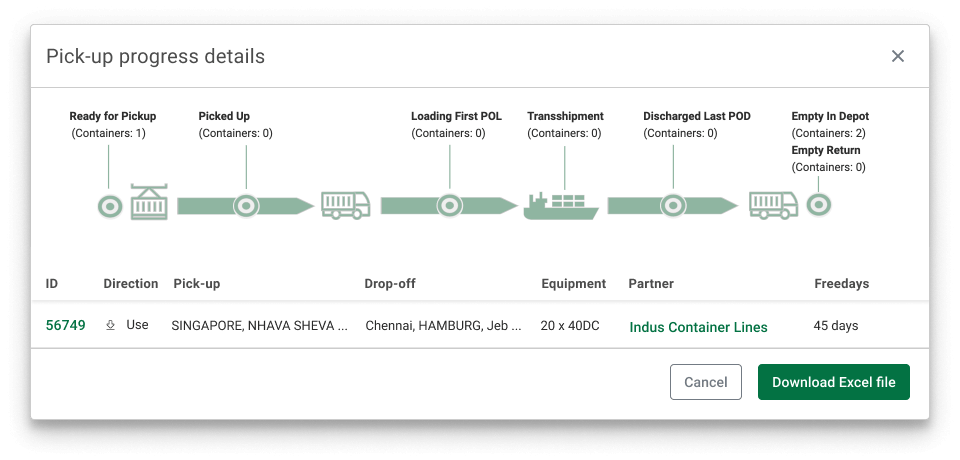
Pick-up and drop-off references are all in one place, and you’ll find container moves as well as shipping details here too.
The system also provides an overview of free days. By knowing if your containers are delayed or has gone to the wrong place, you can preempt issues and dodge unnecessary fines. See this blog on demurrage and detention to learn more about the shipping penalties to avoid.
Another added benefit? It’s easy to share tracking information with both your customers and colleagues through the xChange platform.
![]()
Track bill of lading easily on our platform
When you sign up as a member of Container xChange, you’ll have access to a transparent marketplace for buyers and sellers. We’ll handle everything in between. Search for containers, negotiate deals, make payments and receive invoices, all in the same place. All prices on the platform are negotiable, so you can sign a deal only when you’re 100% comfortable with every aspect of it.
With us, it’s quick and easy to increase your fleet, whether you want to buy or lease containers. Once you’ve got your fleet up and running, you’ll be able to easily manage your entire container logistics process from the comfort of your couch, with our fully automated system.
Are you ready to save time and money, by tracking your fleets automatically? Learn how Container xChange can help you track your entire container fleet all in one place. Neatly and efficiently! Click below to start today.
Track bill of lading: Common FAQs
Can you track a bill of lading?
You can track a bill of lading using the bill of lading number. The bill of lading number can help the shipper to locate the position of a container along its journey.
How can I find my bill of lading number?
You can find your bill of lading number easily by looking at the top of your bill of lading document. Here you will see spaces for the shipment reference number, as well as a quote identification number. These numbers help to identify and track your shipment, as it moves towards its final destination.




